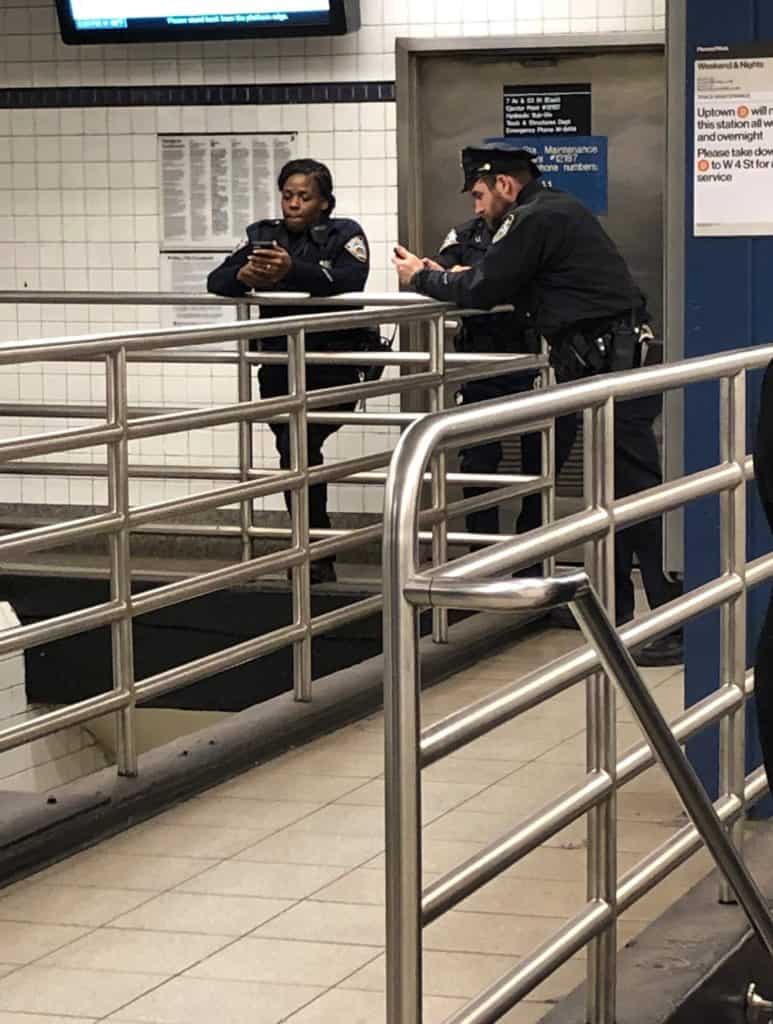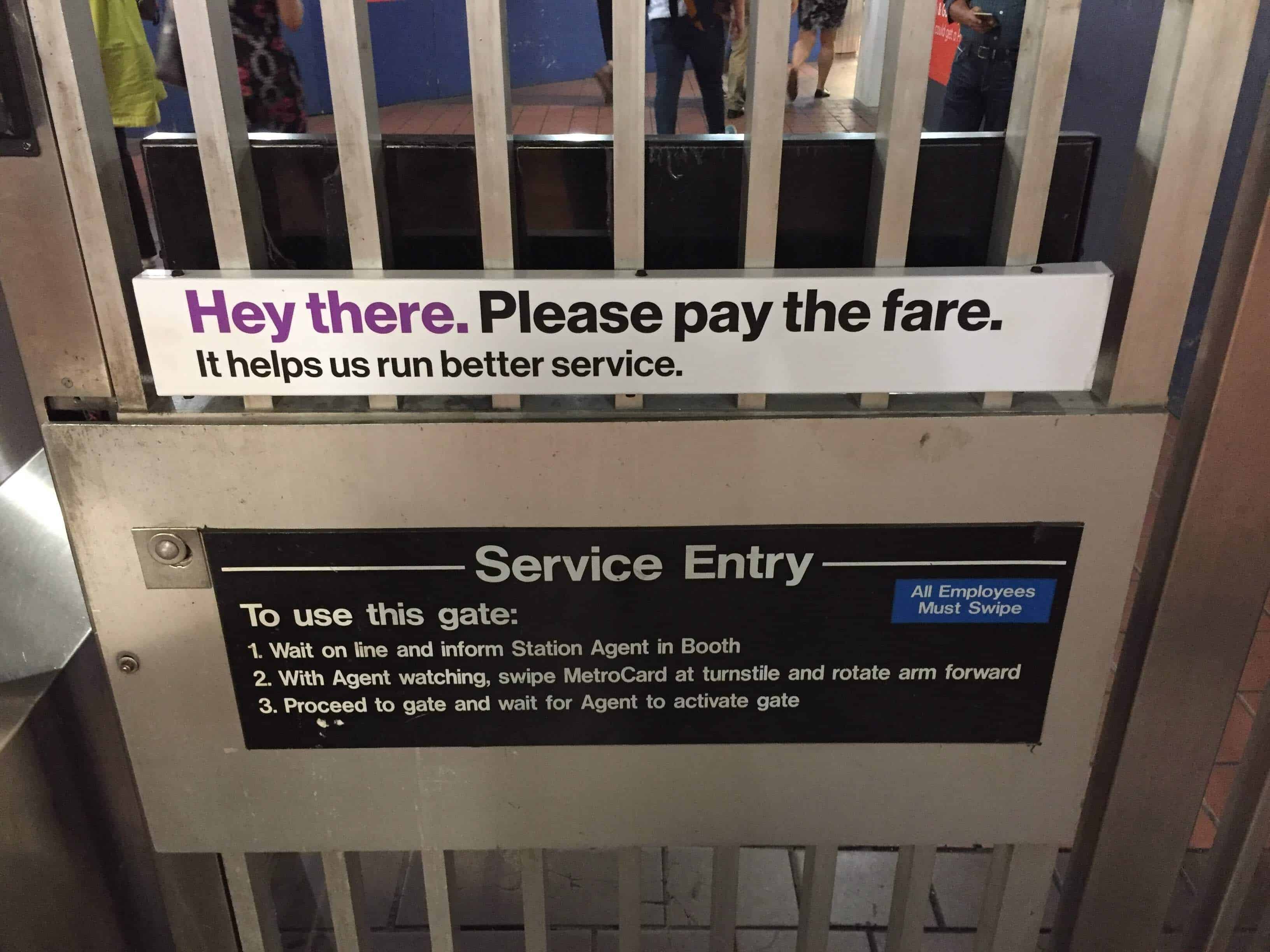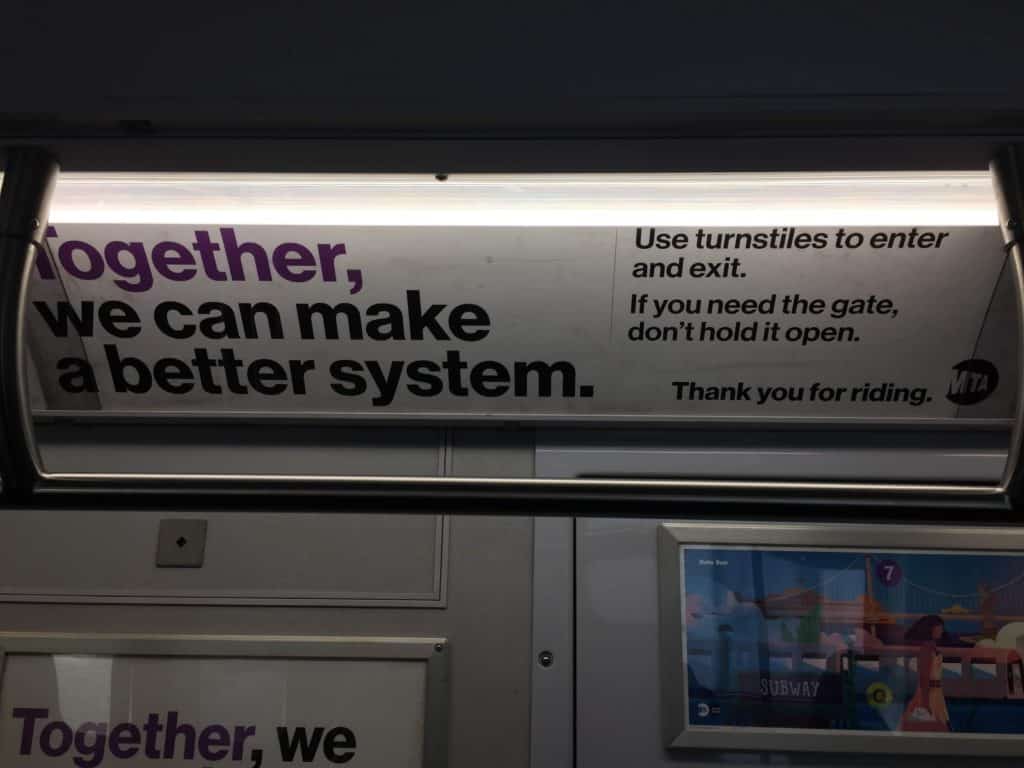A new YouTube genre has gone viral in New York City. This fall, NYPD cops became social media stars inside the city’s subway stations, thanks to iPhone videos recorded by MTA passengers. At home, Facebook and Twitter users watched the officers – sometimes a dozen at a time – swarm fare-evaders, tackle a candy vendor, point loaded guns into a crowded subway car, and arrest a crying woman for selling churros without a permit.
On November 1, activists from Decolonize This Place led hundreds of demonstrators through Brooklyn in protest against Governor Cuomo’s plan to hire 500 new state cops to patrol MTA stops, where they’ll join an existing team of 2,500 watchdogs in uniform. In the interim, Mayor de Blasio has greenlit an equivalent Fare Enforcement Task Force that has sent additional NYPD to 100 “fare evasion hotspots.”
Ostensibly, the main purpose of the subway cops is to deter fare evasion and thereby help the MTA avoid financial catastrophe. In order to deter fare evasion, they occasionally have to brutalize someone (often a young black or brown person) who can’t afford the $2.75 it costs to get home, to work, or to school – as if someone who can’t afford $2.75 doesn’t already have enough problems.
The cure is worse than the disease
The math here is a little fuzzy. If the average NYPD officer makes about $41 per hour, each subway cop would have to deter 15 fare evaders every hour to earn their salary. It seems unlikely. The MTA’s own chief financial officer estimated that Cuomo’s new MTA enforcers will cost $249 million over the next four years, but by his calculation their anti-evasion tactics will add only $200 million to the farebox over the same period.
On the other hand, one might argue that, without anyone to hand out tickets to fare evaders, no one would buy a MetroCard, and then the MTA couldn’t afford to run the trains. Evidently, the present quantity of law enforcement in our subways makes a lot of New Yorkers uncomfortable, but most of them probably would admit that practicality demands some mechanism in place to persuade the majority of riders not to jump the turnstiles: if not arrests, then at least the possibility of a fine.
The inherent problem of such a mechanism – that is, that the financial penalties intended to discourage fare evasion will inevitably go to riders who already couldn’t afford the much smaller fare itself – may seem unavoidable to most New Yorkers. If we therefore consent to this system, how do we ensure that the MTA creates enough incentive for riders to swipe their MetroCards without turning each subway station into a miniature police state? What’s the right balance to strike?
Without the subway, there is nothing
In order to try to answer this question, we must first understand a few basic facts about the New York City Subway. Operated by the New York City Transit Authority (a subsidiary of the MTA), the subway hosts roughly six million riders a day in Manhattan, Brooklyn, Queens, and the Bronx. Its annual operating expenses total about $8.7 billion (more than half the MTA budget), but it plays a primary role in facilitating a local economy of $1.5 trillion. Whether they use it or not, every New Yorker benefits from the New York City Subway because, without it, the entire city – its commerce, its social life, even its other public services – would grind to a halt.
Business owners depend on it to bring their employees to work. Drivers depend on it because, if not for the subway, so many cars would clog the roads as to render them unusable. A city of New York’s size and density couldn’t survive without a subway, which remains the most efficient way to move large numbers of people around.
For this reason, we all pay for the subway through a number of taxes. Specifically, New York City and New York State dedicate a slim portion of their general revenue from income and property taxes to the MTA, and then they deploy a number of small, specific taxes whose revenues go entirely to the MTA, including a payroll tax, a petroleum tax, and a tax on taxi trips.
“Unfare” financing
By far, the strangest of the taxes collected specifically on behalf of the MTA is the one known as “fare.” Fare, as many readers must know, is a tax of $2.75 per bus or subway trip, charged to each rider at the point of service. Fare is a regressive tax, which means that the poorer you are, the more you’ll pay as a percentage of your total income: whether you make $20,000 per year or $2 million per year, the subway costs $2.75. Obviously, $2.75 is a more significant bill for the former passenger than the latter.
Generally, fair-minded people tend to prefer progressive taxes because they believe that taxpayers should shoulder more of the cost of society’s civil and social infrastructure if they’ve reaped a greater bounty from that society – or, simply, that wealthier people should pay more in taxes because wealthier people can afford it. In January, the MTA will begin open enrollment for its Fair Fares program (now in a trial phase), which will allow the city’s poorest residents to pay half-price for the subway, but its stingy cutoff point – $12,490 in annual income for a one-person household – will leave out many struggling New Yorkers, thus diminishing its corrective effect on the regressive nature of MTA fare.
A superior tactic for making the New York City Subway more just is the one known as “fare evasion,” discussed earlier in this article. Fare evasion works as follows: some city residents can’t afford to pay for the subway, so instead of swiping a MetroCard before entering, they dodge the turnstile or sneak in through the service gate. Under this system, middle-class and wealthy MTA passengers throw in a few bucks per ride, but those for whom a $2.75 fee would constitute a meaningful burden quietly sidestep the collection process. Thus, fare evasion informally mitigates the regressive structure of the tax.
Fare evasion has a few problems – for instance, hurdling the turnstile may be difficult for elderly or handicapped people – but the major problem is that it’s illegal. It’s illegal likely because the government doesn’t trust its citizens to apply the technique honorably. Again, if the NYPD ceased fare enforcement, thus freeing impoverished fare evaders of the MTA’s regressive tax, wouldn’t everyone else, after a while, stop paying the fare as well? Instead of a regressive tax, we’d eventually have no tax at all (except for all the other taxes that contribute 62 percent of the MTA’s annual budget).
Two ideas
Is there any way to thread the needle here? It may require some creativity, but we could start just by scaling down the police presence in the subways.
 My own suspicion is that we could remove all the cops from the stations, and New York’s bourgeoisie would continue to pay the fare out of habit. But a lack of fare enforcement would probably persuade some borderline cases – people for whom the subway price is an inconvenience but not a serious challenge – to ride for free. Unfortunately, to hit the ideal level of fare evasion, we may have to continue to ensure that fare evasion comes with a sense of risk: that way, the people who do it are the ones who need to do it – they prove their need by submitting to the danger of a possible fine.
My own suspicion is that we could remove all the cops from the stations, and New York’s bourgeoisie would continue to pay the fare out of habit. But a lack of fare enforcement would probably persuade some borderline cases – people for whom the subway price is an inconvenience but not a serious challenge – to ride for free. Unfortunately, to hit the ideal level of fare evasion, we may have to continue to ensure that fare evasion comes with a sense of risk: that way, the people who do it are the ones who need to do it – they prove their need by submitting to the danger of a possible fine.
But how real does the risk have to be? Yes, if no one ever got ticketed for fare evasion again, the broad MTA ridership would eventually catch on. But I have an idea for that.
Here it is: what if the MTA hired actors and, in collaboration with the NYPD, periodically staged fare evasion crackdowns in highly visible locations? A couple times a week inside popular subway stations, the general public would see phony tickets handed out to turnstile-jumping performers and therefore would assume that they’d better continue refilling their MetroCards. At the same time, fare evaders would, out of need, continue to jump the turnstiles in spite of the “danger.”
But the beautiful part is that there would be no real danger anymore: we would now have a system of fare enforcement that wouldn’t depend on penalizing the poor. It would depend only on stagecraft. The NYPD could continue to rack up hits on social media by occasionally arranging high-speed chases with professional stuntmen playing the “fare evaders.”
Of course, this proposal, too, has a few flaws. One is its clandestine quality; the other is that many, many poor people don’t evade the subway fare. Presumably some have made a principled commitment to following the law even when the law is stupid, no matter how dear the cost to themselves; for others, perhaps, the fear of cops is so intense that they’d rather spend the night hungry than risk an encounter with law enforcement.
The sad truth is that, if we really want to make the MTA completely fair to everyone, we can’t rely on realistic, pragmatic solutions like turning the subway cops into theater performers. The true answer is bolder but simpler: make the subway (and the buses) free to ride for everyone.
“Free subway rides! How would we pay for that?” our conservative friends (and most of our liberal ones) will ask. The answer: duh – we’re already paying for it. Making the subway free wouldn’t increase the cost of providing subway service – it’d just mean that we’d pay for the cost through progressive taxation instead of regressive fare collection. I don’t pay a fee every time I want to use the city sidewalks for a stroll, but somehow the sidewalks still get funding.
I mean, don’t I already send the government money every April? Just tack the cost of my MetroCard onto the bill – in fact, take a little extra, and make the trains run on time from now on.










